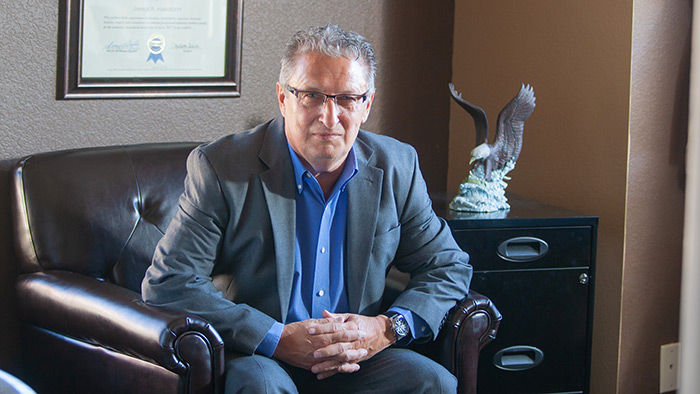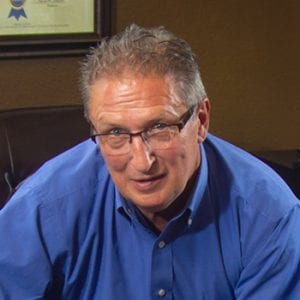A ‘forever focus’ on financial preparedness
A ‘forever focus’ on financial preparedness

Jay Hardesty, MRFC • Golden, CO
Ashton Wealth Management • Money Concepts Capital Corp.
Read full biography below
Proactive Advisor Magazine: Jay, talk about what motivated you to become a financial advisor.
My world started to change in 1996 when my father had an accident that resulted in a severe head injury. I had been working successfully in the real estate industry in Colorado. I decided I needed to move back to upstate New York to help with my father’s care and assist my mother, coordinating with my brother. My father had to enter a long-term-care facility. Unfortunately, my mother’s health also started to fail.
My parents, I came to realize, had been emotionally and financially unprepared for the consequences of a sudden and costly health situation. They also, frankly, were not fully aware of the planning they should have been doing for their retirement needs. This triggered my thinking about making a career change. Soon after, I decided I wanted to become a financial advisor. I picked up some great experience working for two major national insurance firms and began my exposure to the investment side of the business. After much training, mentoring, and hard work, I became an independent financial advisor.
My goal, what I call my “forever focus,” is to help families and businesses pursue a sound financial future. I want to help them guard against not only the financial drain but the emotional stress that can result from a lack of preparedness and a passive attitude toward their finances. Our mission statement is simple: “Every person that comes in contact with us finds a better way.” That might not necessarily be with our firm if we are not the best fit. But we will try to help everyone find the right resources for their needs.

What types of clients do you work with?
I consider myself to be more of a “country doctor” as a financial guide, rather than a Beverly Hills plastic surgeon. What I mean is that we will work with people from all walks and stages of life, with no set requirements on assets or net worth. Our client families cover the full spectrum, from very affluent retirees to younger families still in their accumulation years.
I think we have seen some abandonment of retirees with median household wealth by fee-based advisors, especially as these clients’ assets decline due to distribution. I have also witnessed younger people being ignored by our industry as they are still building assets. In response, our firm developed a flat-fee model, based upon age bands, so that both of these groups—and their critical needs—won’t be left behind.
Retirees cannot afford a significant mistake in their planning or investing—they no longer have an active income that they can use to help them recover. Younger clients can gain so much financial ground by starting early with the right support and guidance. Also, I believe the traditional fee-based advisors may tend to focus too much on assets under management, rather than the complete needs and risk management of a sound goals-based financial plan. We still offer the traditional fee-based asset-management model for clients who prefer that, but with added review and monitoring as we pursue their goals together.
Client protection is paramount with us, which is one of the many reasons we are housed in an inviting home-based environment, with greater control of sensitive information. We take pride in being accessible to clients and are happy to answer questions that come up outside of office hours. We may not have our clients’ lives in hand, but we do have their life savings in hand, and we take that responsibility with great reverence. However, I joke with clients that “not only do you know where I work, but you know where I sleep at night.” I have been able to build relationships with clients that run deep. I enjoy socializing with clients, going for coffee or a meal and hearing how they and their families are doing.
Describe your financial-planning process.
We consider ourselves educators. Together with individuals, families, and businesses, we explore ways to understand the unique financial issues that are fundamental to their long-term financial security. As appropriate, we work in concert with a client’s current legal and tax advisors to create an orchestrated and integrated team approach.
Our first stage is a deep discovery process where we learn about our clients’ families, values, experiences, goals, and potential “headwinds.” We then analyze and prepare several assessments. These usually include a personal balance sheet; retirement analysis; family needs assessment; and analysis of their investment, educational-funding, and estate-transfer planning. We then work closely with clients to help them clarify financial goals, prioritize their financial objectives, and evaluate their attitudes around investment risk.
“We are very cognizant of the risks that our clients face, especially retirees.”
The analysis and goal-setting lead to developing a financial plan, recommending appropriate products and strategies, implementing steps in order of priority, and then scheduling periodic review sessions to evaluate progress versus objectives. We use sophisticated financial-planning software throughout the process, which enables clients to aggregate accounts and see real-time information. It also allows us to examine changes to assumptions or analyze new scenarios very readily. What, for example, might be the impact to a client’s retirement-income plan if they decide to purchase a vacation home?
As I approach the planning process, I always keep in mind a simple acronym that fundamentally guides everything we do. I call this building the “RIGHT” financial plan. “R” stands for building a strong relationship, which means active listening and an interactive, consultative process. “I” represents the intergenerational nature of our planning process, probing the needs and potential financial impacts involving a client’s children and parents. Hopefully, we can create an intergenerational dialogue around finances, health care, and educational funding that did not exist before. “G” stands for goals. I emphasize to clients that those are both hard and soft goals—both the quantifiable financial objectives and the more aspirational lifestyle goals. “H” represents our holistic approach, which recognizes that each element of a plan must be coordinated with the others. Finally, “T” stands for truthfulness and transparency in the client-advisor relationship, which really is incumbent upon both parties. We can work through just about any issue, market-related or otherwise, if we are both being upfront and have a relationship built on mutual respect and trust.
What is your overall investment philosophy in developing client portfolios?
 Just as we want to bring a high degree of experience and knowledge to the financial-planning process, we want to work with a team of third-party professionals who are equally proficient in their own specialty areas. That might be an attorney, tax professional, or an investment manager. I have some difficulty with advisors who say they are money managers. If they were truly money managers, they would probably have to sit in front of seven screens, 14 hours a day, to keep on top of everything, leaving no time to serve their clients’ overall needs.
Just as we want to bring a high degree of experience and knowledge to the financial-planning process, we want to work with a team of third-party professionals who are equally proficient in their own specialty areas. That might be an attorney, tax professional, or an investment manager. I have some difficulty with advisors who say they are money managers. If they were truly money managers, they would probably have to sit in front of seven screens, 14 hours a day, to keep on top of everything, leaving no time to serve their clients’ overall needs.
Through our broker-dealer, Money Concepts, we have access to institutional-level money managers, including managers who provide socially responsible and impact investing strategies. These money managers meet the stringent standards of GIPS (Global Investment Performance Standards) certification.
Overall, I am a believer in professional active investment management for at least some portion of a client’s portfolio. We have an avalanche of financial, economic, and geopolitical information hitting us every day. Trying to decipher what is important and what isn’t is critical. And more information doesn’t necessarily mean more relevant and applicable knowledge. That’s where properly executed active management can filter through and determine what’s important, in terms of an investment manager’s models, algorithms, and indicators. When evaluating managers, we conduct due diligence that examines such factors, along with their overall history, transparency, systems, reporting, support, and disciplined stewardship.
We develop a customized investment portfolio for clients based on their specific goals, time horizons, and risk profiles. While it is difficult to generalize, we typically look for portfolios that are highly diversified and can weather the cycles of the market over a lengthy time frame. There will usually be an allocation between strategic core investments and more tactical actively managed strategies. The other important factor about the use of third-party active managers is their ability to employ sophisticated risk-management methodologies as a component of their strategies. We work collaboratively to help them understand our clients’ objectives and jointly develop recommended allocations between strategy types.
Ultimately, we are very cognizant of the risks that our clients face, especially retirees. This might be market risk, sequence-of-returns risk, longevity risk, or health risks. We apply risk-management principles throughout a client’s financial plan, and that most definitely includes the investment plan. We act as fiduciaries first and foremost, acting in the client’s best interests. That approach, I believe, has been a hallmark of our practice and leads to strong and enduring client relationships.

Building the “RIGHT” financial plan for clients
Jay Hardesty is president of Ashton Wealth Management, located in Golden, Colorado. Mr. Hardesty’s firm provides comprehensive wealth-management services that help clients develop a personalized road map for achieving their financial goals. He employs a disciplined financial-planning process for clients that embraces five core factors he says can lead to the “RIGHT” financial plan:
- R: Building a strong relationship that involves active listening and an interactive, consultative process.
- I: Understanding the intergenerational nature of the planning process, probing the needs and potential financial impacts involving a client’s children and parents.
- G: Setting both hard and soft goals—including quantifiable financial objectives and more aspirational lifestyle goals.
- H: Using a holistic planning approach that recognizes that each element of a financial plan must be coordinated with the others.
- T: Emphasizing truthfulness and transparency in the client-advisor relationship, which is incumbent upon both parties. This leads to developing a relationship built on mutual respect and trust.
Recent Posts:
 Jay Hardesty is president of Ashton Wealth Management, located in Golden, Colorado. Mr. Hardesty says his firm provides “comprehensive wealth-management services that help clients develop a personalized road map for achieving their financial goals.”
Jay Hardesty is president of Ashton Wealth Management, located in Golden, Colorado. Mr. Hardesty says his firm provides “comprehensive wealth-management services that help clients develop a personalized road map for achieving their financial goals.”
Mr. Hardesty was raised in upstate New York. His father was a small-business owner and his mother worked in banking. In college, he studied accounting, finance, and the biological sciences. He later worked in the health and fitness industry, eventually owning his own facility. When he sold his business, Mr. Hardesty moved to Colorado, where he entered the real estate industry. He then spent several years as a representative for major national insurance firms and eventually became an independent financial advisor. Mr. Hardesty is a Master Registered Financial Consultant (MRFC). He has deep experience working with retirees and families that have dependents with supplemental or special needs. He finds it greatly rewarding to work with the veterinary community in Colorado and is appointed with the American Veterinary Medical Association as a representative for AVMA Life.
Mr. Hardesty speaks on financial education topics at workplaces, churches, schools, and community centers. He is also involved with a variety of community, civic, and charitable organizations. Mr. Hardesty is active with, or supports, Big Brothers Big Sisters of America, Special Olympics Colorado, Leadership Golden, and The Denver Foundation. He serves on the board of Victims Outreach, where he focuses on fighting elder abuse and financial manipulation, and is a past board member of the Community Foundation serving Southwest Colorado and the Manna Soup Kitchen. Ashton Wealth Management is a team sponsor of Racer X Cycling.
Mr. Hardesty and his wife enjoy “the magnificent area of Colorado” they live in. He is an avid hiker and cyclist and is the “proud owner and rider of an Indian motorcycle.”
Disclosure: Jay R. Hardesty is an independent contractor of Money Concepts. All securities through Money Concepts Capital Corp. Member FINRA/SIPC. Ashton Wealth Management is an independent firm and not affiliated with Money Concepts.
Photography by Diane Huntress

